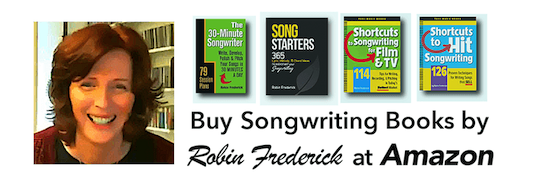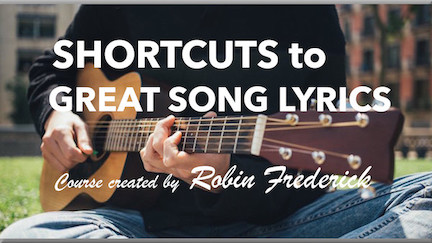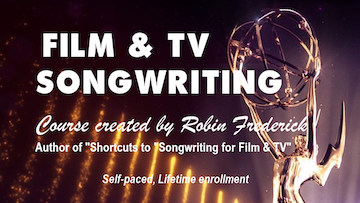Why this song?
Most songwriters know that the Contemporary Country genre pumps out some of the most well crafted songs in the business. What you might not know is that these songs can provide a gold mine of song crafting techniques you can use to add appeal to your own songs, no matter what genre you’re writing in.
Sure, Country has its own distinctive musical twang but many of the lyric and melody skills are universal. Read on and I’ll show you a few. I’ll use Dierks Bentley’s recent Country hit “Gone” as an example.
“Gone” – Dierks Bentley
Songwriters: John Wiggins / Dierks Bentley / Jon Randall
TECHNIQUES TO HEAR AND TRY
• Learn to build an unshakable song structure.
• Use this lyric power tool: Exaggeration!!!
• Get a grip on a huge chorus melody.
Listen to the song. Read the lyrics.
Watch the lyric video on YouTube.
Read the lyric here.
GENRE/STYLE:
Contemporary Country
(What is a genre? Watch this video.)

“Gone” has the characteristic production style and vocal sound of today’s top Country singles. Indeed, the song is clearly aimed at Country hit radio. But the songwriters employed a lot of broad, contemporary hit songwriting tools along the way—plenty of vivid imagery, a melody with lots of catchy hooks and rhythmical interest, and a sympathetic male character in an emotional situation. Setting aside the Country-specific references in the lyric, let’s see what we can learn.
SONG STRUCTURE
“Gone” is a perfect example of today’s most reliable hit song structure in all genres.
VERSE / PRE-CHORUS / CHORUS
VERSE / PRE-CHORUS / CHORUS
BRIDGE / CHORUS
STRUCTURE AT A GLANCE
Take a look at the lyric and you’ll spot the structure right away because each section is clearly different from the others, even on the page.
VERSES: 4 lines each
PRE-CHORUS: 3 lines
CHORUS: 8 lines long
BRIDGE: 6 lines
This is a good indication that each section has a distinctive melody, different from the other sections, making each section easy for the listener to identify, so they always know where they are.
LENGTH OF PHRASES
You’ll also see that in some sections (the verses and bridge) the lines are all about the same length. But in the pre-chorus, the third line is obviously longer than the first two and the chorus has a range of phrase lengths from very short to long. This is especially clear when you listen to the melody. (See the MELODY section below.)

Hit songs in the Country, Pop, and Rock genres all have easily recognized song structure. Listeners can quickly pick up on the difference between the verse, pre-chorus, and chorus. While R&B, EDM, and Singer-Songwriter are a little more relaxed, mainstream hit radio has shown a clear preference for songs with solid structure.
DEVELOPING YOUR STRUCTURE
Each section of a song has a job to do and this song is a good example of that.
VERSES: Both verses give listeners information about what’s going on in the singer’s life (his situation).
PRE-CHORUS: This section introduces the problem the singer faces, building anticipation going into the chorus. (“Over-drinking, overthinking ever since you left.”)
CHORUS: The chorus expresses the singer’s feelings about the situation. He’s been “gone,” checked out, not getting on with his life at all.
BRIDGE: The bridge is a list that sums up the wreck his life has become. Bridges are a good spot for summing up or stepping back for an overview.
You can use a sectional outline like this one in almost any genre with some adaptations. If you’re a Singer-Songwriter, you might use the second verse and bridge to take us deeper into the singer’s feelings. In Pop/Dance, you could use the pre-chorus and chorus to motivate the singer to find the strength to move on. In Rock, the singer might get angry and decide he doesn’t care after all.
The idea of developing a song from verse to pre-chorus to chorus—from information to anticipation to emotional release—is present in all genres. You choose how you want to apply it.

LYRICS
Here’s one of my favorite techniques for creating a vivid lyric that will keep listeners coming back to listen again. It works in any genre.
USE EXAGGERATION
Even though the singer is going through an unhappy breakup, listeners will be entertained by the list of things that happen as a result. There’s humor here, but there’s also truth. It’s just a little—well, a lot—overstated.
Boss thinks I’ve been sick for days
And mama’s probably on her way
‘Cause I ain’t picked up the phone
Took a trip down memory lane
Checked into Hotel Heartbreak
Passed rock bottom on the way
He hasn’t even been outside to pick up the mail so…
All the neighbors probably think I’m dead.
These examples take a normal human response and push it over the top. When using exaggeration, be sure to keep it tethered to reality, even if only slightly. In this case, it makes us smile but we can still sympathize with what the singer is going through.
It works in any genre
You can use the technique of exaggeration in any genre to evoke a range of emotions in the listener. You’ll hear it in Rock songs like Queen’s “We Are the Champions,” in a Pop/Dance hit like Adele’s “Set Fire to the Rain,” in Bruno Mars’ R&B hit “That’s What I Like,” in a Singer-Songwriter lyric like “Start a Riot” by BANNERS, and Lord Huron’s Indie Folk song “Ends of the Earth.”
Why does it work? Song lyrics can go where conversational speech can’t. It wouldn’t be believable if someone said these things. (Just try speaking the lyrics to some of those song I listed!) But put them to a melody and they sound fine. Listeners enjoy over-the-top song lyrics. They’re surprising, evocative, and deliver the impact that ordinary speech cannot.
– Try It Now –
Look through some of the lyrics you’ve written and rewrite a couple using exaggeration. Go as far as you can while still staying in touch with the truth that lies underneath.
BONUS TIPS: ADD MORE IMAGES & ACTIONS TO YOUR LYRIC
Looking for ways to pack more images and action into your lyric? (When are we NOT looking for that?) These songwriters used three different strategies to add more visual energy to their lyric.
1. Use comparisons to describe an emotion
It’s always a challenge to describe what the singer is feeling. One way to do it is to compare it to something else. In this lyric, the singer feels as if things went wrong “faster than that freight train, farther than that airplane, sadder than a country song.” He also feels like he “checked into Hotel Heartbreak” and “passed rock bottom on the way.” All are images or actions that communicate his emotional state.
2. Describe what the singer does
Actions are a great way to add visuals to your lyric and get ideas or feelings across to the listener. After all, we often find out how someone else is feeling by watching how they act. In the bridge, this lyric becomes a list of the things the singer does or doesn’t do.
3. Show the situation from another angle
This song could have started with a familiar statement like “Since you left me I’m feeling lost and blue.” Instead, we see other people’s reactions to the singer: his buddies, his boss, and his mom. It’s fresh and it gives the listener a better chance to relate to what’s happening. They’d probably react that way themselves.
MELODY
This is a beautifully crafted melody that’s right on target for the Contemporary Country market. Yet it shares some of the same melody crafting techniques you hear in Pop or Dance hits with their huge choruses and catchy, rhythmical phrasing.
WRANGLING A BIG CHORUS MELODY
A big chorus like this one can end up sounding messy and unfocused if you don’t know how to manage it. Here, the songwriters have used a couple of current melody writing tools that keep the chorus melody well-organized and easy to remember.
Listen to the chorus melody on Youtube.
Use repetition with variation
The chorus opens with two short phrases that echo each other melodically and lyrically (“I’ve been gone, I’ve been gone”) followed by a longer melody phrase (“I’ve been sittin’ on the couch watching TV”).
Then the whole melody pattern—two short phrases followed by a long one—repeats with a new lyric (“all day long, all day long, I’ve been tryin’ to figure out how a good thing went wrong”).
Listeners love a melody that feels organized but not too predictable. Repetition creates organized patterns for the listener. But too much repetition becomes predictable. So a repeated phrase might feature a few changes in the note pitches (as these do) and then be followed by a line that’s quite different, maybe much longer, smoother, or choppier.

Change up the pace
About halfway through this chorus, there’s an attention grabbing change of pace (“faster than that freight train, farther than that airplane”). Listeners were probably expecting another repetition of the pattern that’s been featured thus far. But no! By doubling the speed of the words, the songwriters surprised listeners and kept them engaged.
Interestingly, once again we’ve got a pair of short phrases that echo each other (“faster than that freight train, farther than that airplane”) followed by a phrase that’s different, slower (“Sadder than a country song”).
So, right there in the chorus, this song offers two ways to use the same pattern of repetition and variation. Pretty cute!
And speaking of a change of pace, notice how the pre-chorus slows the pace of the notes building anticipation as it leads listeners to the chorus. Another cool rhythm trick you can use in any song style!
– Try It Now –
Listen to the verse, pre-chorus, and chorus melody of this song. Notice how many melody lines are repeated, where they’re repeated, and what follows afterwards. Check out the changes in pace in the pre-chorus and chorus. Sing along with the melody to get a feel for the patterns.
Now, take a look at a couple of your own melodies. Could you be using more patterns? Could you add a change of pace to create more interest? Try it. Record it. Then come back and listen later. Do you like your new melody better? if so keep going.
BONUS TIP: A COOL MELODY & LYRIC TECHNIQUE
Notice how the end of one line of the chorus runs right into the next line.
I’ve been sittin’ on the couch watching TV…
All day long, all day long
“All day long” which appears to be the end of one line, is actually the beginning of the next pair of short phrases. We’ve already heard that pair once at the beginning of the chorus, so we recognize it when we hear it again. But it also wrapped up the previous line without so much as a pause.
This technique of extending a lyric line so it continues into the next melody phrase creates a huge amount of momentum that draws the listener forward. On the other hand, when a lyric thought and melody phrase end at the same time, there’s a sense that things are resolved, that something has ended. Rather than moving forward, the listener has an opportunity to drop out. Try this technique to keep listeners engaged.
CHORDS
This is a three-chord hit song. Yup, we still write ‘em! And not just in the Country genre. From “Stay With Me” by Sam Smith to “All About That Bass” by Meghan Trainor, three-chord hits are here to stay.
To play along with the recording of “Gone,” capo your guitar on the first fret or transpose your keyboard +1.
| F | Dmin Bb | – Repeat over and over and over.
See the chords with lyrics here.
PRODUCTION
Country hit production has its own distinct sound, so I’m not suggesting that you look there for production ideas for other genres. Spend time studying good productions in the style you’re writing in and look for the characteristics that set it apart from Country.
IS THIS A FILM & TV SONG?
What do you think? Let’s take a look at the pros and cons.
► The chorus is very wordy with a lot of motion in the melody that attracts the listener’s attention. Good for radio, bad for Film & TV. They want to keep the viewer’s attention on the scene, not the song.
► It’s not an obvious “story” song (it doesn’t convey a sequence of events) which is a plus for Film & TV. But it does depict specific people’s reactions (my boss, buddies, Mama) so the first verse is out. The chorus might work, but it’s probably too “on the nose,” describing what’s happening in the scene too closely. Keep your lyric focused on emotion and let the scriptwriter create the scene.
► Country songs are not used as much as other genres in Film & TV because they tend to indicate a rural U.S. location (even though Country music is popular around the world). While this song could be used as source music coming from a car radio, jukebox, or roadhouse band, overall there won’t be many potential uses.
ANSWER: This song could work as source music. It would not work as song-score under a scene.
-Try It Now-
Listen to “Gone” by Dierks Bentley and look for the song craft I’ve described here. Pull out one of your unfinished songs or start a new one and use at least two of these song crafting ideas.


